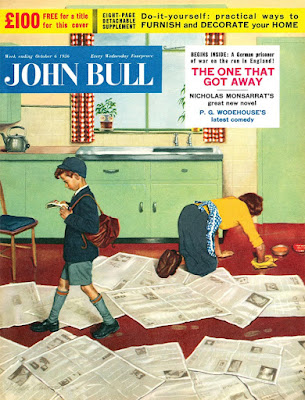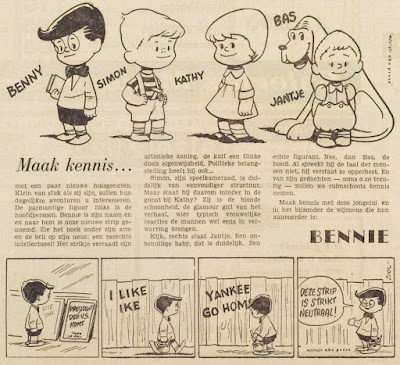As it happens, those “few examples” were pretty much the only Benny strips readily available on the Web. That’s likely because the feature appeared in only one newspaper: London’s Daily Herald, from July 27, 1959, through October 14, 1961. Information about the strip’s creator — Derek Chittock, who hid behind the pseudonym “Droc” for Benny — also is rather thin.
Thanks to the British Newspaper Archive and newspapers.com, we were able to assemble all but a few dozen of the strip's entire run. Now armed with so many examples, it quickly became obvious that Benny was a deliberate attempt to mimic Charles Schulz’s popular strip. Unlike Peanuts, though, Benny appeared only Monday through Saturday; there were no Sunday strips ... undoubtedly because the Daily Herald didn't publish on Sundays.
Click on all images, for larger, easily readable versions.
But let’s begin with some background on Chittock.
He was born on February 21, 1922, and — after five years at London’s Slade School of Art — became an excellent artist and painter strongly in the Norman Rockwell tradition, as this magazine cover demonstrates. His work belonged in the Socialist Realism style, and he’s known to have exhibited at the Royal Academy and New English Art Club. He also was active with the Communist Party of Great Britain for roughly a decade — and was an art critic for its Daily Worker newspaper — until he resigned his membership following the Soviet invasion of Hungary in 1956. Be that as it may, those leanings remained evident in Benny, which often was openly political during its entire run. Chittock died on his birthday, in 1986; he was 64.
You can learn a bit more about him at this Lambiek Comiclopedia entry.
In addition to the artistic style Chittock employed for Benny — which strongly evokes Schulz — the two strips share these traits:
• Both involve children who are wise beyond their years, and appear to be roughly the same age ... although the only time age is mentioned in a Benny strip, the character says that she’s 5, whereas the Peanuts characters are a few years older.
• Both strips have characters who often break the fourth wall, to address the reader directly.
• Both feature a blend of one-off gag strips and longer “serials” that run a week or more.
• Panel composition, word balloon use, and lettering style are very similar.
• Both occasionally name-check real-world events and individuals. Characters in Benny cite (among others) Austrian biologist Hans Haas, U.S. President Kennedy, jazz musician Johnny Dankworth, and orchestra conductor Malcolm Sargent.
• No adults appear in either strip.
• Both feature dog companions who “talk” — usually to the reader — via thought balloons. That said, the pooches in Benny are just-plain-dogs, and don’t have anything approaching Snoopy’s fantasy escapades.
As you’d expect, Benny also employed plenty of Brit-speak (a few of which sent us to an online dictionary). These included Fairy cakes, Sherbet dabs, Ice lollies, Conkers (a traditional British game played with the seeds of a horse chestnut tree, of all things), Scotch egg, St. Swithin’s Day, Winkle-picker shoes, swotting, Tombola (a lottery-style board game) and, of course, British money.
On a few occasions, Benny is referred to as a “strip cartoon,” rather than a “cartoon strip.”
It took almost half a year for Chittock to refine his artwork to the cleaner look subsequent strips possessed; his earlier efforts were visibly weaker.
So, let’s meet these kids:
The debut strip, shown at the top of this post, introduced Benny and an infant known as Baba. Benny is philosophical, quite intelligent, well-read and highly aware of world events; he’s a thinker. Baba initially was mostly silent, or "talked" baby gibberish, as befit his age; toward the end of the first year, he began to “comment” in thought balloons.
Simon and Kathy debuted the following day. Simon is a clever craftsman, carpenter, builder and inventor. Kathy often mangles the English language much like Sally, in Peanuts; Kathy also can be humorously dense.
Enid, a hound dog, debuted two days later.
Arnold, who often frets about being overweight, debuted on September 17, 1959. He fancies himself an aristocrat junior stockholder and property owner, chews on chocolate cigars, and calls everybody “Old Man.” He’s greedy, spoiled, full of his own importance, and constantly thinks of unscrupulous ways to part his friends from their pocket change.
Linda, an unabashed sexpot, debuted on October 22, 1959. She’s a total snob, and believes herself to be an upper-crust socialite. She’s proud to be a “parasite,” and her speech is affected; as one example, when she says the phrase “high time,” it's spelled as “haigh taime.”
Igor, a roving reporter for Russia's Junior Pravda, visited for several weeks, beginning on November 30, 1959. In one strip, he insisted that Shakespeare was Russia's national poet.
Fletcher, Arnold's American cousin, joined the full-time cast on August 2, 1960. He frequently extolled the virtues of the United States, while (mostly) denigrating the UK.
By this point, with Chittock's cartooning style firmly established, one couldn't help noticing that Simon often looked a lot like Schroeder, Kathy strongly resembled the original Patty, and Fletcher had definite shades of Charlie Brown. (Good grief!)
Lionel, the Chelsea beatnik, joined the gang on November 28, 1960. Aside from his scruffy appearance and beat-style wardrobe, he called everybody — boys and girls — Daddy-O.
The final permanent newcomer was Scruffy, an adorable mongrel dog who debuted on January 23, 1961. He became Lionel's official pet three weeks later, at which point Enid — the strip's original dog — vanished forever. (One assumes Scruffy was more fun to draw.)
What follows is a baker's dozen of my favorite strips:
Chittock occasionally messed with newspaper strip conventions, as with this accident Baba had with a large balloon, on December 14, 1959.
Simon built all sorts of toys, vehicles and imaginative contraptions, often having wild adventures with them, as with this strip on January 16, 1960.
February 15, 1961: A typical example of Kathy behaving like Charlie Brown's sister Sally.
July 21, 1961: A pointed swipe at the United States. (Ouch!)
July 21, 1961: A pointed swipe at the United States. (Ouch!)
The final Benny strip, on October 14, 1961. Although the series exited without fanfare, and without any explanation the following week, it looks like Chittock knew the end was coming, since this gathers almost the entire cast. (Baba is inexplicably missing.)
During roughly the middle of the strip's UK run, Benny also appeared in the Dutch social-democratic newspaper Hey Vrije Volk (The Free People), where it was called Bennie. This run began October 18, 1960, and concluded April 17, 1961. The strips weren't concurrent in the two newspapers; Chittock apparently cherry-picked those he considered his best, for his Dutch readers, relying mostly on the first five characters introduced.
Meet ... a few new housemates. Small in stature as they are, their daily adventures will interest you. The perky figure on the left is the main character. Bennie is his name, and our new comic strip is named after him. Look at the book under his arm and the glasses on his nose: a true intellectual! The bow betrays his artistic talent, the calf a good dose of stubbornness; he also has political interests...
Simon, his playmate, is clearly of simpler structure. But does that make him less popular with Kathy? She is the blonde beauty, the glamour girl of the story, whose typically feminine reactions sometimes confuse the men.
On the right is Jantje. A small baby, that’s clear. Then Bas, the dog. Although he does not speak the language of men, he understands them perfectly. And of his thoughts — sometimes so sad — we will take ample notice.
Meet these youngsters, and in particular the wise guy who is their leader: Bennie.
The newspaper headline in the first panel reads "President of the U.S. Comes," and Benny's comment in the final panel is "This comic is strictly neutral!"
You can see half a dozen more of the Dutch strips at this site.
********
So, what do you think? Was Benny a deliberate imitation of Peanuts? Or was Chittock merely paying affectionate tribute to Schulz?

























No comments:
Post a Comment